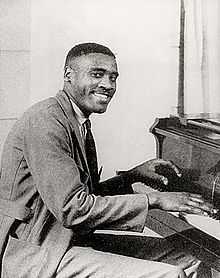Leroy Carr
| Leroy Carr | |
|---|---|
 | |
| Background information | |
| Born |
March 27, 1905 Nashville, Tennessee, United States |
| Died |
April 29, 1935 (aged 30) Indianapolis, Indiana, United States |
| Genres | Chicago Blues, Piedmont blues |
| Instruments | Piano |
Leroy Carr (March 27, 1905 – April 29, 1935)[1] was an American blues singer, songwriter and pianist, who developed a laid-back, crooning technique and whose popularity and style influenced such artists as Nat King Cole and Ray Charles. He first became famous for "How Long, How Long Blues" on Vocalion Records in 1928.[2]
Life and career
Carr was born in Nashville, Tennessee. Although his recording career was cut short by an early death, Carr left behind a large body of work.[2] He had a long-time partnership with guitarist Scrapper Blackwell. His light bluesy piano combined with Blackwell's melodic jazz guitar to attract a sophisticated black audience. Carr's vocal style moved blues singing toward an urban sophistication, influencing such singers as T-Bone Walker, Charles Brown, Amos Milburn, Jimmy Witherspoon, Ray Charles among others.[3]
Count Basie and Jimmy Rushing used some of Carr's songs and Basie's band shows the influence of Carr's piano style.[4]
His music has been covered by notable artists such as Robert Johnson, Ray Charles, Big Bill Broonzy, Moon Mullican, Champion Jack Dupree, Lonnie Donegan and Memphis Slim.
Carr died of nephritis shortly after his thirtieth birthday.
References
- ↑ Allmusic biography
- ↑ 2.0 2.1 Russell, Tony (1997). The Blues: From Robert Johnson to Robert Cray. Dubai: Carlton Books Limited. pp. 52–53. ISBN 1-85868-255-X.
- ↑ Shaw, Arnold (1978). Honkers and Shouters. New York: Macmillan Publishing Company. pp. 8–9. ISBN 0-02-061740-2.
- ↑ Keil, Charles (1991). Urban Blues. Chicago, IL: University of Chicago Press. pp. 65–67, 107. ISBN 0-226-42960-1.
Bibliography
- Wald, Elijah. Escaping the Delta: Robert Johnson and the Invention of the Blues. HarperCollins, 2004. ISBN 0-06-052423-5
External links
|